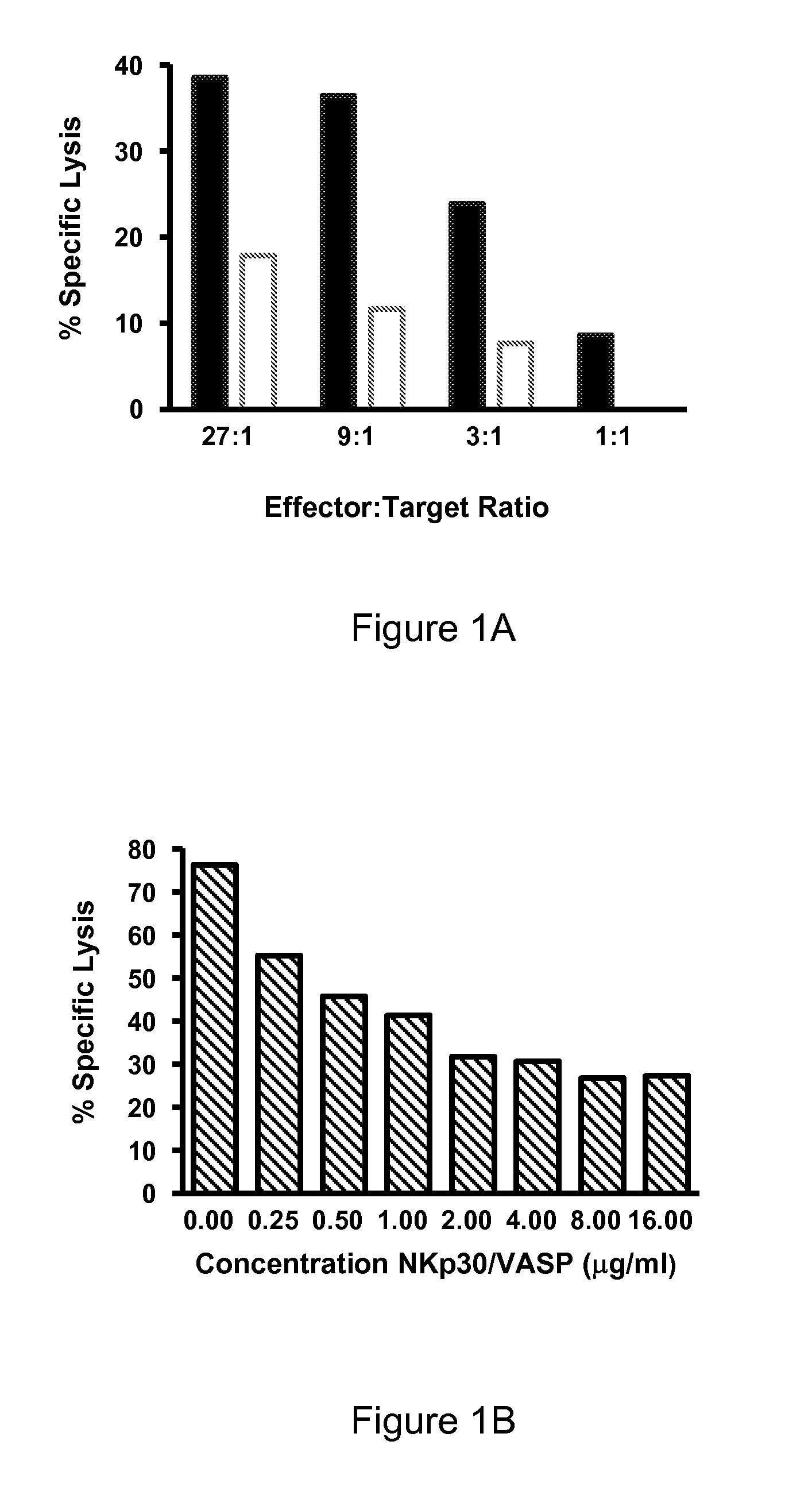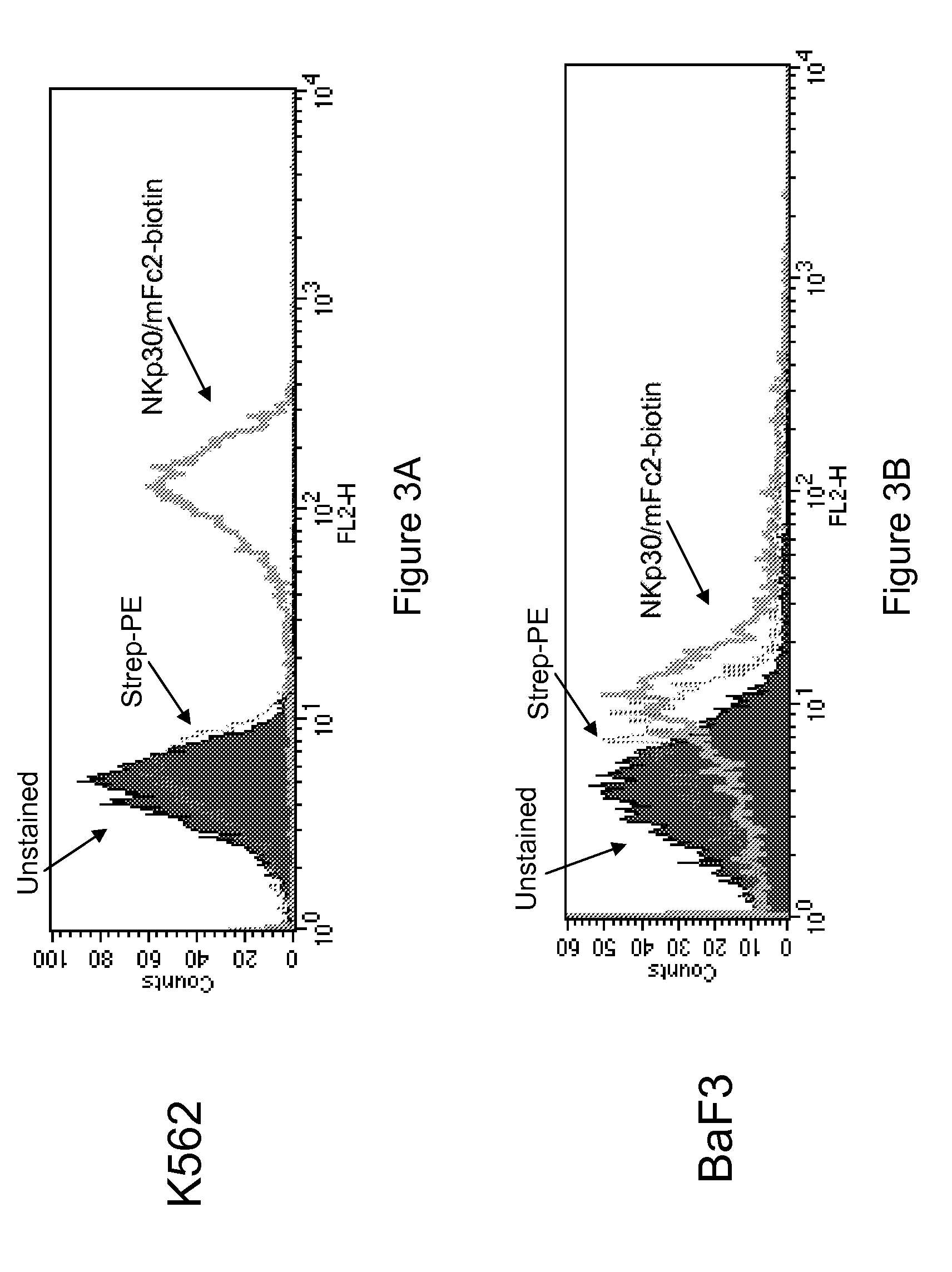Anti-zB7H6 antibody-drug conjugates
a technology of antibody-drug conjugates and zb7h6, which is applied in the direction of drug compositions, immunological disorders, peptides, etc., can solve the problems of ineffective nk cell performance in performing normal function, i cannot always prevent cytolysis by nk cell, etc., and achieve the effect of depleting or inhibiting growth
- Summary
- Abstract
- Description
- Claims
- Application Information
AI Technical Summary
Benefits of technology
Problems solved by technology
Method used
Image
Examples
example 1
Inhibition of NK-92 Cytolytic Activity Against K562 Targets with Soluble NKp30 / VASP
[0397]A cytolytic assay was performed with NK-92 cells as effectors against K562 targets.
[0398]NK-92 cells were washed 1× with HBSSF (Hank's buffered saline (Ca, Mg Free)+5% FBS) and resuspended in HBSSF at 1.35×106 / ml (to achieve a 27:1 ratio). 150 μl of washed cells were plated in the top row of a U-bottom 96-well plate and serially diluted (1:3) into HBSSF.
[0399]K562 target cells were washed 1× with HBSSF and labeled at 1×106 cells / ml in 10 μM calcein AM Molecular probes #C1430 (2.5 μl / ml of 4 mM stock in DMSO, 4 mM=4 mg / ml) for 60 minutes at 37° C. Labeled cells were washed 2× in HBSSF and 1×106 cells were resuspended in 20 ml HBSSF (5000 cells / 100 μl). 100 ul of suspended target cells were added to diluted effectors for a total volume of 200 ul. A soluble form of NKp30 (NKp30 / VASP A1683F) was also added to some sets of serially diluted wells at a concentration of 2 μg / ml.
[0400]Effector and target...
example 2
Soluble NKp30 Specifically Binds K562 Cells
[0403]K562 cells were probed by FACS with a soluble form of NKp30 (NKp30 / mFc2 (SEQ ID NO:8), containing the extracellular domain of NKp30 and a murine Fc fragment). K562 cells were resuspended in PBS / 2% FBS at a concentration of 1.6×106 cells / ml (160,000 cells / sample). 100 μl samples were aliquoted and 1 μl of whole human IgG (Jackson #009-000-003) added to each. NKp30 / mFc2 probe was added at a concentration of 2 μg / ml together with 10 μg / ml Heparin and 100-fold mass excess of a VASP protein (NKp30 / VASP or a control VASP protein, human zB7R1 / VASP (SEQ ID NO:12) or B7-DC / VASP (SEQ ID NO:13)). Cells were incubated for 1 hour on ice and washed with 2 ml cold PBS. Washed cells were resuspended in 100 μl of PBS / 2% FBS with 1 μl PE anti-mIgG (Jackson 115-116-071) and incubated for 30 minutes on ice. Cells were then washed twice with 2 ml cold PBS, resuspended in 500 μl of PBS, and analyzed for PE staining on a FACSCalibur.
[0404]As shown in FIG. 2...
example 3
Crosslinking of K562 Cells and Biotinylated NKp30 / mFc2
[0406]In an effort to identify an NKp30 ligand on K562 cells, K562 cells were cross-linked with biotinylated NKp30 / mFc2, followed by immunoprecipitation and mass spectrometry.
[0407]Four samples, the sample of interest and three negative control samples, were analyzed. The sample of interest was K562 cells incubated with biotinylated NKp30 / mFc2. The three negative control samples were K562 cells with no NKp30 and BaF3 cells with and without NKp30. 100×106 cells were washed once in PBS and resuspended in 2 ml binding buffer (RPMI, 3 mg / ml BSA, 20 mM HEPES), in the presence or absence of 2 μg / ml NKp30 / mFc2-biotin, and incubated for 2 hours on ice. Cells were washed (once in binding buffer, once in PBS), resuspended in 1 ml of crosslinking reagent (3 mm BS3 [Pierce 21580]), and incubated for 30 minutes at room temperature. 7.5 μl of 2 M Tris (pH 7.4) was then added for a final Tris concentration 15 mM, and cells were incubated for 15...
PUM
| Property | Measurement | Unit |
|---|---|---|
| concentrations | aaaaa | aaaaa |
| concentrations | aaaaa | aaaaa |
| concentrations | aaaaa | aaaaa |
Abstract
Description
Claims
Application Information
 Login to View More
Login to View More - R&D
- Intellectual Property
- Life Sciences
- Materials
- Tech Scout
- Unparalleled Data Quality
- Higher Quality Content
- 60% Fewer Hallucinations
Browse by: Latest US Patents, China's latest patents, Technical Efficacy Thesaurus, Application Domain, Technology Topic, Popular Technical Reports.
© 2025 PatSnap. All rights reserved.Legal|Privacy policy|Modern Slavery Act Transparency Statement|Sitemap|About US| Contact US: help@patsnap.com



